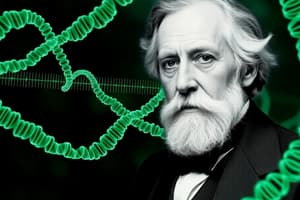Podcast
Questions and Answers
Which characteristic is associated with a protean career?
Which characteristic is associated with a protean career?
- Job security and stability
- Focus on organizational advancement
- Hierarchical progression
- Self-directed development (correct)
In a traditional career, the organization is primarily responsible for the employee's career trajectory.
In a traditional career, the organization is primarily responsible for the employee's career trajectory.
True (A)
What is the first step in the career development process?
What is the first step in the career development process?
Self-assessment
The degree of mobility in a protean career is typically _______.
The degree of mobility in a protean career is typically _______.
Match the steps in the career development process with their descriptions:
Match the steps in the career development process with their descriptions:
What are core values emphasized in a protean career?
What are core values emphasized in a protean career?
Balancing work and life issues is not considered a challenge in career development.
Balancing work and life issues is not considered a challenge in career development.
What is the primary focus of the performance measurement in a protean career?
What is the primary focus of the performance measurement in a protean career?
Which of the following is NOT a method of formal education in employee development?
Which of the following is NOT a method of formal education in employee development?
The RIASEC model categorizes jobs primarily into six types.
The RIASEC model categorizes jobs primarily into six types.
What type of assessment tool evaluates performance from multiple sources?
What type of assessment tool evaluates performance from multiple sources?
The _____ typology includes job categories for people interested in mechanical and athletic abilities.
The _____ typology includes job categories for people interested in mechanical and athletic abilities.
Match the career types with their descriptions:
Match the career types with their descriptions:
Which of the following is an example of an experiential program?
Which of the following is an example of an experiential program?
These approaches to employee development focus solely on formal education.
These approaches to employee development focus solely on formal education.
The _____ Assessment is used to understand personality types in relation to career choices.
The _____ Assessment is used to understand personality types in relation to career choices.
What is the primary purpose of a mentor in employee development?
What is the primary purpose of a mentor in employee development?
Employee development solely occurs through formal training programs.
Employee development solely occurs through formal training programs.
What term describes the relationship where a less experienced employee learns from a seasoned employee?
What term describes the relationship where a less experienced employee learns from a seasoned employee?
A career is a pattern of work experiences that people have over their __________.
A career is a pattern of work experiences that people have over their __________.
Which type of relationship involves incidental development rather than intentional development?
Which type of relationship involves incidental development rather than intentional development?
Match the following types of employee developmental relationships with their appropriate descriptions:
Match the following types of employee developmental relationships with their appropriate descriptions:
In previous generations, it was common for individuals to switch companies frequently for career advancement.
In previous generations, it was common for individuals to switch companies frequently for career advancement.
What is the common term for moving up the career ladder through promotions with more pay and responsibility?
What is the common term for moving up the career ladder through promotions with more pay and responsibility?
Flashcards
Employee Development through Job Experiences
Employee Development through Job Experiences
Developing skills and knowledge through practical work experiences, often involving challenges and proving oneself.
Mentor
Mentor
A senior employee guiding a less experienced one, fostering their development.
Coach
Coach
A peer or manager who helps an employee improve skills, provides feedback, and motivates them.
Supervisor/Coworker Relationship
Supervisor/Coworker Relationship
Signup and view all the flashcards
Role Model
Role Model
Signup and view all the flashcards
Support Group/Network
Support Group/Network
Signup and view all the flashcards
Career
Career
Signup and view all the flashcards
Traditional Career Model
Traditional Career Model
Signup and view all the flashcards
Protean Career
Protean Career
Signup and view all the flashcards
Traditional Career
Traditional Career
Signup and view all the flashcards
Self-Assessment
Self-Assessment
Signup and view all the flashcards
Reality Check
Reality Check
Signup and view all the flashcards
Goal Setting
Goal Setting
Signup and view all the flashcards
Action Planning
Action Planning
Signup and view all the flashcards
Work/Life Balance
Work/Life Balance
Signup and view all the flashcards
Career Development Process
Career Development Process
Signup and view all the flashcards
Holland Typology
Holland Typology
Signup and view all the flashcards
Work Experiences
Work Experiences
Signup and view all the flashcards
Assessment Centers
Assessment Centers
Signup and view all the flashcards
360-Degree Feedback
360-Degree Feedback
Signup and view all the flashcards
Performance Appraisal
Performance Appraisal
Signup and view all the flashcards
Myers-Briggs Type Indicator (MBTI)
Myers-Briggs Type Indicator (MBTI)
Signup and view all the flashcards
Job Assignments
Job Assignments
Signup and view all the flashcards
Interpersonal Relationships
Interpersonal Relationships
Signup and view all the flashcards
Study Notes
Chapter 10: Developing Employees & Their Careers
-
Objectives of the chapter include explaining the value of employee development practices for organizations, describing how such practices align with overall HR strategy, explaining typical career patterns and perspectives on success, describing common development methods, and identifying career management challenges along with solutions.
-
Employee development is the process of preparing employees for changes like new jobs, responsibilities, or requirements. Training focuses on building skills for current roles, generally a short-term focus. Career development encompasses supporting employees in progressing their work experiences throughout their careers.
-
A graphic depicts the relative proportions of employee development that occur on-the-job, through people, and via training.
-
A strategic framework for employee development shows different HR strategies (Bargain Laborer, Loyal Soldier, Free Agent, Committed Expert) based on external/internal focus and cost/differentiation orientation.
-
Employee development is strategic when it is aligned with the organization's labor orientation (internal or external) and strategic direction (cost leadership or differentiation).
-
Approaches to employee development include work experience, formal education, assessment & feedback, and interpersonal relationships.
Approaches to Employee Development
-
Formal education includes workshops, short courses, lectures, simulations, business games, experiential programs, training centers, courses, certifications, and licensing.
-
Assessments & feedback gather information to provide feedback on employee behavior, communication style, or skills, including career assessments (Holland typology), and multisource assessments (from employees, peers, managers, and customers).
Holland Typology
- Realistic (R): jobs like mechanics, electronics, and farming (mechanical & athletic abilities).
- Investigative (I): jobs like scientists and technicians (math & science abilities).
- Artistic (A): jobs like musicians and writers (imagination).
- Social (S): jobs like counselors and teachers (people-related abilities).
- Enterprising (E): jobs like salespeople and executives (leadership & public speaking abilities).
- Conventional (C): jobs like analysts and bankers (clerical & math abilities).
The World of Work Map
- A map depicts various occupations (categories) based on whether they involve working with people, data, or things.
Other Assessment Tools
- Myers-Briggs Type Indicator (MBTI)
- Assessment Centers
- Benchmarks Assessment
- Performance Appraisal
- 360-Degree Feedback
Approaches to Employee Development
- Work experiences involve the combination of relationships, problems, demands, tasks and other features of an employee's jobs; most employee development occurs through job experiences.
- Key job experience events/types include job assignments, interpersonal relationships, and types of transitions.
Types of Developmental Job Experiences
- Job Rotation (Temporary Lateral Move)
- Job Transfer (Permanent Lateral Move)
- Promotion (Upward Move)
- Enrichment of Current Job
- Demotion (Downward Move)
Developmental Relationships
-
Developmental relationships enable employees to enhance skills and knowledge about the organization and customers by interacting with experienced members.
-
Mentors are senior, experienced employees who assist less experienced colleagues ("protégés"); coaches are peers or managers who enhance motivation, skills development, and feedback.
Types of Developmental Relationships
- Coach/Sponsor: Development of employee skills improving work performance (deliberate).
- Mentor: Development of inexperienced employees through personal interaction (deliberate).
- Supervisor/Coworker: Development naturally occurring (incidental).
- Role Model: Nonreciprocal learning desired traits and behaviors.
- Support Group/Network: Individuals with shared characteristics support each other.
What are Careers Like Today?
-
A career is a pattern of work experiences throughout one's life. Past generations frequently involved a single company throughout a career.
-
Today, careers involve movement both laterally and hierarchically, potentially including contract work and small business ownership.
Protean Career
- Protean career is one that frequently alters based on changes in individual interests, abilities, values, and the work environment. Individuals in protean careers are more personally responsible for career development and this emphasis on psychological success often encompasses continuous learning.
Differences between Traditional and Protean Careers
- Traditional careers prioritize organizational commitment, advancement, and position level/salary, typically with lower mobility and the organization bearing wider responsibility. Protean careers depend more on psychological success, individual commitment, and higher mobility with wider personal responsibility.
Career Development
- The career development process includes self-assessment (identifying interests, values, personality, and skills), reality check (determining the realism of self-assessment and aligning with opportunities), goal setting (setting milestones for future achievements), and action planning (making specific plans to achieve goals).
Steps in the Career Management Process
- Employee responsibility: Identifying opportunities and needs for improvement, identifying what needs are realistic for development.
- Company responsibility: Providing assessment of information to identify strengths, weaknesses, interests, and values; communicating performance evaluation and long-range plans.
- Shared goal setting and action planning: Identifying achievable goals, the method, timelines, and resources needed to reach them.
Sample Career Development Plan
- This outlines competencies (strengths and areas for improvement), career goals (long-term and short-term), next assignments, and training/development needs.
Some Important Career-Development Challenges
- Orientation of new employees
- Reducing employee burnout
- Balancing work/life issues
- Developing a diverse workforce
- Managing international assignments
Test Your Knowledge
- Scenario 1: Identify the type of career trajectory based on promotions from sales person to VP of Sales.
- Scenario 2: Identify the assessment method a candidate uses in leaderless group discussions and in-basket exercises.
- Scenario 3: Identify the phase of career management process a candidate is in, when understanding career possibilities based on strengths.
AI for Learning & Development
- Personalize learning experience, accelerated employee skill acquisition, and better alignment between employee skills and business strategy. Intelligent AI-driven agents are being used now.
Studying That Suits You
Use AI to generate personalized quizzes and flashcards to suit your learning preferences.





